Multi-currency wallets have simplified the way international transactions take place. Many users, those who own a digital business have benefited from the implementation of a digital wallet that allows them to manage their international transactions without having to struggle with fluctuations in the exchange rate.
A Multi-Currency wallet can simplify cross-border transactions, allowing your business to reach a wider audience across the globe.
However, not all businesses are utilizing these wallets to their full potential. This is because the majority of these businesses are unaware of methods to implement a multi-currency wallet in their business.
In this post, we’ll help you understand what a multi-currency wallet is and how to build one for your business. We will also take a look at the types of multi-currency wallets and how you can use them to expand your business and boost your sales.
So without further ado, let’s begin!
What is a Multi-Currency Wallet? Overview
Multi-currency wallets, as the name suggests, is a wallet that supports transactions that involve different types of currencies from different parts of the world.
This is a wallet that helps in managing, storing, and exchanging different types of currencies including both fiat and cryptocurrencies.
You see, international transactions are difficult to manage as these are done in respective currencies and to make these transactions legit.
They must be exchanged for the currency that is legal tender in your country. Previously, this issue used to bother international transactions for a business, limiting the reach of the business.
How Does a Multi-Currency Wallet Work?
It is the implementation of multi-currency wallets has simplified the entire process.
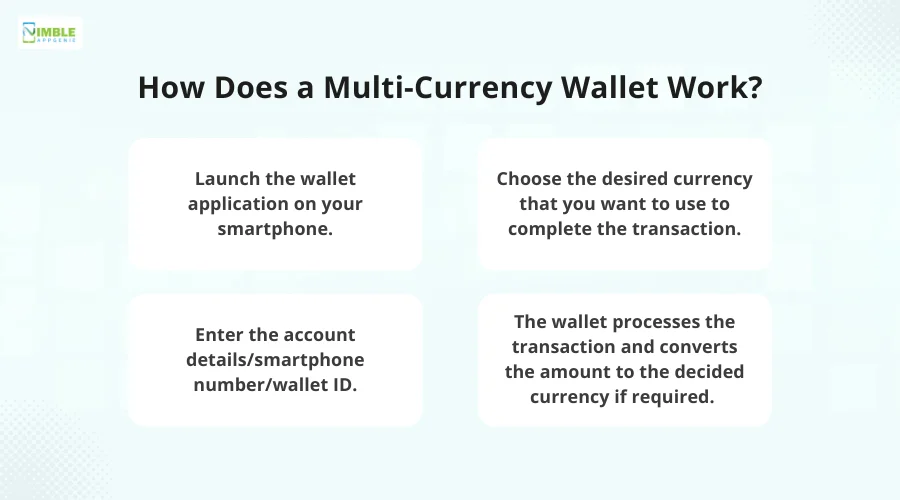
Today, it only takes 4 steps to complete an international transaction using a multi-currency wallet, –
- Step 1 – Launch the wallet application on your smartphone.
- Step 2 – Choose the desired currency that you want to use to complete the transaction.
- Step 3 – Enter the account details/smartphone number/wallet ID.
- Step 4 – The wallet processes the transaction and converts the amount to the decided currency if required.
Features of a Multi-Currency Wallet
All these transactions are possible thanks to a bunch of digital wallet features that are embedded in a multi-currency wallet.
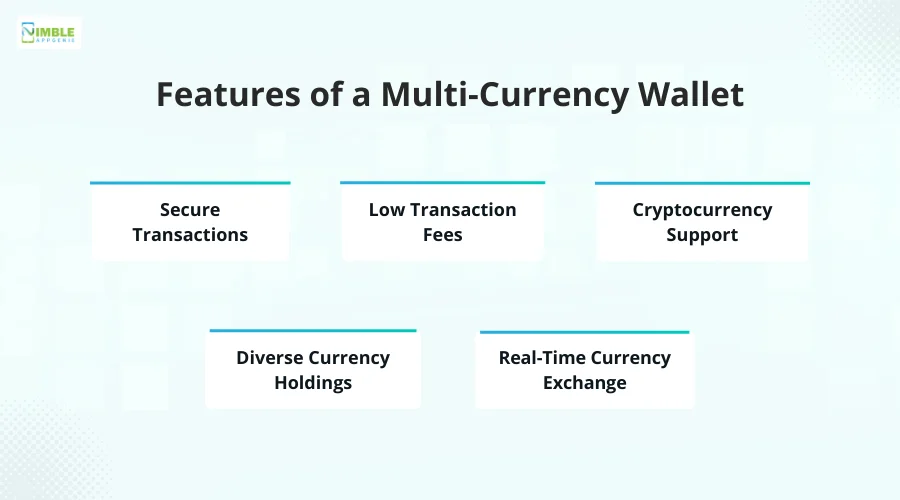
Some of the core features that make these wallets a must-have for businesses and remittance users include –
- Secure Transactions
- Low Transaction Fees
- Cryptocurrency Support
- Diverse Currency Holdings
- Real-Time Currency Exchange
With ease of usage and beneficial features, a multi-currency wallet is designed to simplify international transactions for businesses and service providers.
Not to forget, sending remittances is also a significant use-case that makes multi-currency wallets a utility application for both individuals and businesses.
Types of Multi-Currency Wallets
Now that you know who can use a multi-currency wallet and how it simplifies a transaction, let us take a look at the types of wallets that support multiple currencies.
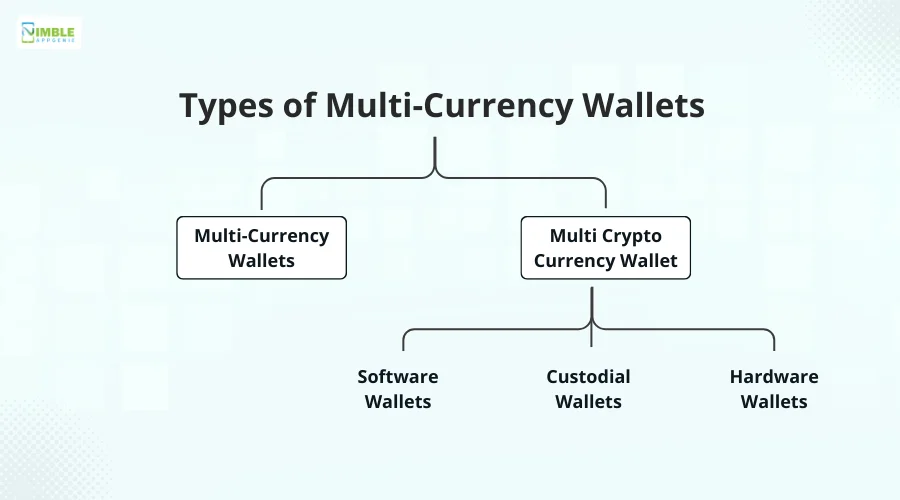
There are 2 types of multi-currency wallets –
- Multi-Currency Wallets – These allow a user to access different types of currencies from their smartphone. You can add money to this wallet in any currency you want and then exchange it instantly to another currency and send it over. These are digital wallet applications that a user can install on their smartphone and finish the transaction.
- Multi Crypto Currency Wallet – If you are into cryptocurrency and manage different cryptocurrencies such as Dogecoin, Bitcoin, Ethereum, etc. You can opt for a multi-cryptocurrency wallet and manage different cryptocurrencies from a single wallet. If we talk about multi-crypto wallets, there are different classifications in them.
These are –
- Software Wallets – Digitally operated via smartphone, used to manage your cryptocurrencies and digital assets.
- Custodial Wallets – These are wallets that are managed by a third-party to take care of your private key for cryptocurrencies.
- Hardware Wallets – These are digital devices that store your private keys offline, offering better security. These are considered non-custodial wallets.
Learn more about custodial and non-custodial wallets here. All in all, you can decide what type of multi-currency wallet you need and what are the reasons you want to use the application.
Benefits of Building a Multi-Currency Wallet for Businesses
Now that you are aware of what these multi-currency wallets are about and how they work. You may be wondering why you should get a multi-currency wallet for your business. Integrating a multi-currency wallet into your business can bring more and more convenience to your users.
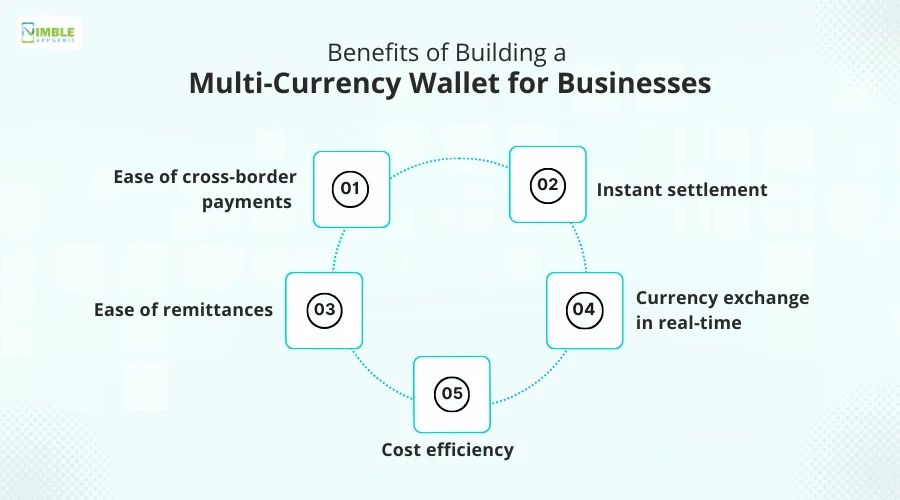
Building a multi-currency wallet for your business can offer the following benefits –
- Ease of cross-border payments.
- Instant settlement
- Ease of remittances
- Currency exchange in real-time
- Cost efficiency
These benefits are enough for any business to adopt a multi-currency wallet. If you too plan to implement the same in your business, you must know how to build a multi-currency wallet that improves your business.
Steps to Build a Multi-Currency Wallet for Your Business
You need technical expertise to begin with the development of a digital wallet. You can hire an e-wallet app developer to guide you through the process.
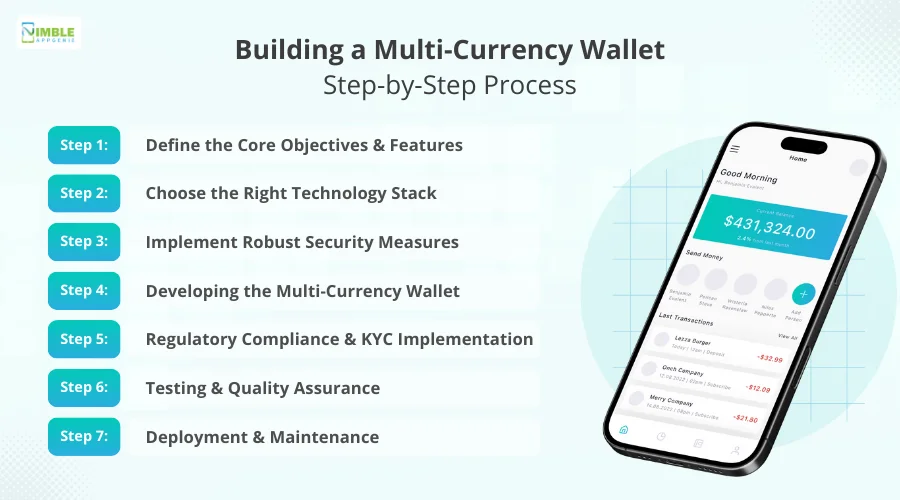
However, if you plan to understand how it is developed, take a look at the following steps –
Step 1: Define the Core Objectives & Features
When approaching multi-currency wallet app development, you need to understand all the necessary aspects required to do so.
Answering questions like – what is the core objective of your wallet? Do you want to allow the use of crypto? Do you plan to make it with the purpose of remittances or daily transactions?
What type of features do you want to offer through this wallet? and more will help you carve the final structure of your wallet, making it easier to move forward with the process.
Step 2: Choose the Right Technology Stack
Based on the features and functionalities you agree on, a tech stack is chosen. Usually, the tech stack to make a digital wallet includes a suitable blockchain platform, a development language, and wallet libraries along with basic development tools.
Choosing the correct technology allows you to be more and more flexible while designing your application and its functionalities.
Not only that, but the right technology stack can boost the scalability of your multi-currency wallet in the long run.
Step 3: Implement Robust Security Measures
Security is a prime factor that makes or breaks your multi-currency e-wallet. Hence, you need to pay attention to the security measures you take while designing your wallet.
A multi-currency wallet requires you to have multiple ways to keep every transaction safe.
These measures include encryption, 2FA (Two-Factor Authentication), and techniques like cold storage.
With the help of these robust security measures, every transaction be it a remittance transaction, a cross-border transaction, or a simple currency exchange, becomes transparent and secure.
Step 4: Developing the Multi-Currency Wallet
Once you have everything figured out, it’s time to bring it all together and develop your multi-currency digital wallet. This is the step when all of your choices are implemented.
The architecture of your multi-currency wallet is designed from scratch and all the necessary functionalities are built. If you have opted for other third-party integrations, all the APIs are used here.
Step 5: Regulatory Compliance & KYC Implementation
Once you have finished the development process, it is time to check if the final built application is compliant with the necessary regulations or not.
Since the application revolves around finances and involves international transactions, different compliances such as AML, KYC, etc. are mandatory to be implemented properly.
In fact, in some regions, it is mandatory to comply with all types of regulations, or else the application will not be released.
Step 6: Testing & Quality Assurance
Once all the steps are carried out and finished, the developed multi-currency application is handed over to the team of quality assurance specialists.
In this step, the application is used continuously to check for different use cases. The performance, accountability, and accuracy of the application are tested in this step.
The quality assurance team ensures that the application is working as expected and there are no failed transactions.
If something is found to be not functioning, it is sent back to the development team for resolution.
Step 7: Deployment & Maintenance
After all the development and tests are performed properly, the application is all set to be opened for public use.
The deployment is planned and all the prerequisites are checked to ensure that the application is ready to be deployed to different stores.
Deployment and maintenance are important for any application as the developed app is created in a closed environment and it may behave differently when opened for all.
All these steps can help you build a balanced multi-currency digital wallet.
All these steps combined can take from 6-12 months depending on the functionalities that you have chosen and the technologies that you are using.
How Much Does it Cost to Develop a Multi Currency Wallet?
Multi-currency wallets can cost you anywhere from 20,000$ to $300,000.
The range is based on different types of feature variations and factors that you opt for while planning your application.

The cost of building a digital wallet can vary depending on different factors.
These factors include –
1. Location of Development Team
The location of developers defines the per-hour rate you will have to pay for the development service. Since it varies from region to region, the cost also varies.
2. Number of Currencies & Chains
In a multi-currency wallet, you need to decide which currencies or which reasons you want to service. The more currencies you integrate, the more APIs are used and hence the cost varies.
3. Implemented Security Measures
For some regions, basic security and encryption is enough to secure a multi-currency digital wallet. While for some, you need additional security measures, which in turn cost more.
4. Expertise of the Development Team
One of the key factors that raises the cost of development for a multi-currency wallet is the experience and expertise of the team you hire. Experienced developers and testing professionals charge on the higher side when compared to less experienced developers.
5. Number of Resources Deployed
The team and resources that you deploy also play a crucial role in the cost of your multi-currency wallet development. If your deployed team only has 2 developers and 1 testing expert, it may cost less but take more time, whereas if the teams are huge, it may cost more.
6. Third-Party Integrations & Tech
The technologies you use to build your application and the third-party e-wallet APIs that you use define the majority of your development budget. The technologies used are not cheap and hence you have to be sure of choosing the best within your budget to minimize the cost.
Naturally, all these factors vary from project to project and hence you cannot spell out the exact cost of developing a multi-currency wallet. However, the varying cost can be considered to be somewhere between $20,000 to $300,000.
Why Choose Nimble AppGenie for Multi-Currency Wallet Development?
Multi-currency wallets require a dedicated team of experienced developers. If you are planning to build and integrate a multi-currency application of your own, you can reach out to Nimble AppGenie, we are the best digital wallet app development company.
We have some of the finest experts in development to guide you through the entire process, bringing your idea to life.
From planning to implementation, our experts are with you from the ideation stage to final deployment, leading you toward success.
Nimble AppGenie offers a 360-degree solution for a multi-currency e-wallet, from development to deployment, assisting you further with proper maintenance and post-deployment assistance.
Conclusion
Building a multi-currency wallet is not everyone’s cup of tea. However, every business must implement it in their system as it allows them to expand their business to international markets, removing cross-border payment barriers.
A dedicated team of developers and a well-planned development strategy can help you build a multi-currency wallet application that gets the job done for your business.
Hope all the steps shared in this post help you make the right decision and integrate a robust and fully functional application that boosts your business.
FAQs

Niketan Sharma is the CTO of Nimble AppGenie, a prominent website and mobile app development company in the USA that is delivering excellence with a commitment to boosting business growth & maximizing customer satisfaction. He is a highly motivated individual who helps SMEs and startups grow in this dynamic market with the latest technology and innovation.
Table of Contents




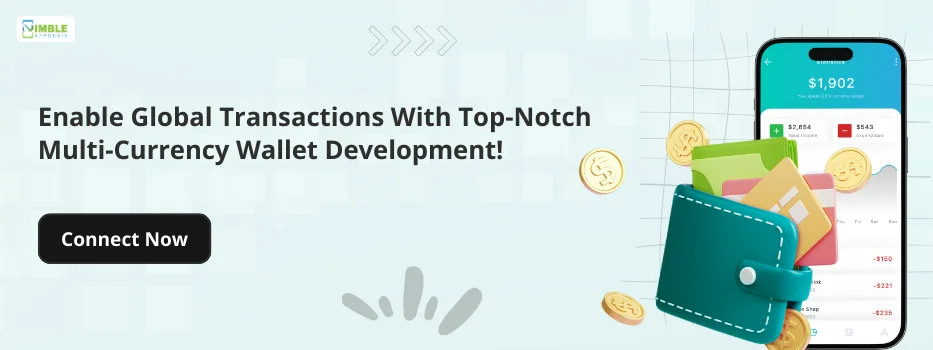
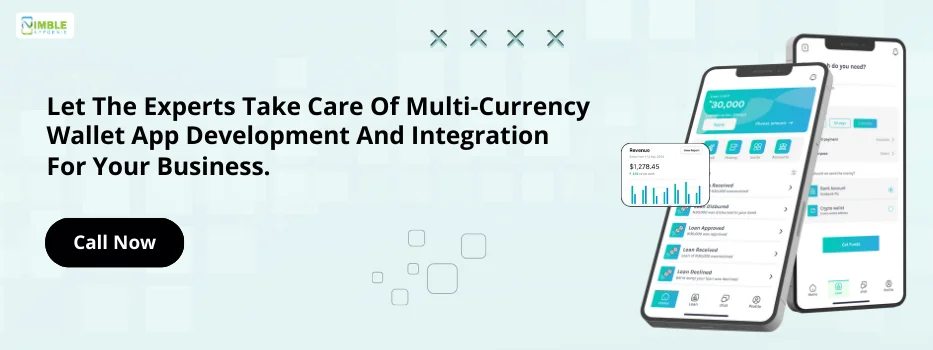
No Comments
Comments are closed.